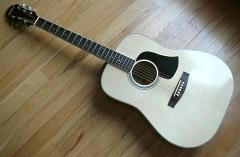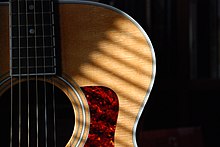Steel-string acoustic guitar
 | |
| Classification | String instrument (plucked) |
|---|---|
| Playing range | |
 | |
| Related instruments | |
| |

A steel-string acoustic guitar, is a modern form of guitar descended from the classical guitar, but strung with steel strings for a brighter, louder sound. Strictly speaking, the terms steel-stringed guitar, classical guitar, and folk guitar all refer to acoustic (that is, non-electric) guitars, though some of these terms refer to different types of instruments (nylon-strung vs. steel-strung). The term "acoustic guitar" is a retronym, since before the invention of the electric instrument, all guitars were "acoustic."
There are many different variations on the construction of, and materials used in, steel-string guitars. More expensive guitars feature solid tonewood tops (often spruce), sides and backs (often rosewood, maple, or mahogany). Lower-priced guitars typically combine solid tops with laminated (layers of wood) backs and sides. Entry-level guitars are usually made entirely of laminated wood. Necks are generally made of mahogany (either Philippine or Honduran) and fretboards are usually made of dense, tropical hardwoods such as rosewood or ebony. The various combinations of the different woods and their quality, along with design and construction elements (for example, how the top is braced), are among the factors affecting the timbre or "tone" of the guitar. Many players and builders feel a well-made guitar's tone improves over time.
Typically, a steel-string acoustic guitar is built with a larger soundbox than a standard classical guitar. Because such instruments must withstand higher string tension than nylon-strung guitars, heavier construction is required overall. Steel-string guitars use different bracing systems from classical guitars, typically using x-bracing instead of the fan bracing used on classical and flamenco guitars. (Another simpler system, called ladder bracing, where the braces are all placed across the width of the instrument, is used on all types of flat-top guitars on the back.) Innovations in bracing design have emerged, most notably the A-brace developed by British luthier Roger Bucknall of Fylde Guitars.
Due to decreasing availability and rising prices of the premium-quality tonewoods, many manufacturers have begun experimenting with alternate species of woods or more commonly available variations on the standard species. For example, some makers have begun producing models with redcedar or mahogany tops. Some have also begun using non-wood materials, such as plastic or graphite. Most luthiers and experienced players agree that a good solid (as opposed to laminated) top is the most important factor in the tone of the guitar and that solid backs and sides can also contribute to a pleasant sound, although laminated sides and backs are acceptable alternatives. Some jazz players prefer laminated backs and sides.
See Guitar for more details on the construction of acoustic guitars.
Another style of acoustic guitar is the archtop guitar. This incorporates a top, either carved out of solid wood or heat-pressed using laminations, that is arched like instruments in the violin family, usually with f-holes rather than a round sound hole. These guitars are most commonly used by swing and jazz players and often incorporate electronics in the form of a pickup. However, many other kinds of acoustic guitars may incorporate these kinds of electronics as well.
There are several prominent American makers of steel-string acoustic guitars. Martin, Guild, Taylor, and Gibson are known for both the quality and price of their instruments. The Selmer-Maccaferri guitar is an unusual-looking instrument, distinguished by its "D"-shaped or longitudinal oval soundhole. It is usually played by those who follow the style of Django Reinhardt. In Europe, several steel string acoustic guitar makers have gained a worldwide reputation, although their production output is small relative to US and Asian makers. Among the leading European brands are Avalon (Northern Ireland), Brook (UK) and Lakewood (Germany).
The standard tuning for an acoustic guitar is EADGBE (low to high), although many players, particularly fingerpickers, use alternate tunings (scordatura), such as "open G" (DGDGBD), "open D tuning" (DADF#AD), or "drop D" (DADGBE). A common mnemonic for standard tuning is "Eddie ate dynamite; good-bye Eddie", which aids beginners in remembering the string tuning sequence from low to high.
One variation on the standard acoustic guitar is the 12-string guitar, which sports an additional doubling string for each of the traditional six strings. This guitar was made famous by artists such as Huddie Ledbetter (also known as Lead Belly), Pete Seeger, and Leo Kottke.

Steel-string guitar music and players
Until the 1960s, the predominant forms of music played on the flattop, steel-string guitar remained relatively stable and included acoustic blues, country, bluegrass, folk, and several genres of rock. The concept of playing solo steel-string guitar in a concert setting was introduced by such performers as Davey Graham and John Fahey in the early 1960s, who used country blues fingerpicking techniques to compose original compositions with structures somewhat like European classical music. Fahey contemporary Robbie Basho added elements of Indian classical music and Leo Kottke used a Faheyesque approach to make the first solo steel string guitar "hit" record. Afterwards came Windham Hill Records which brought in elements of Celtic music to join the mix in this now-thriving genre. Today, scores of artists are steel-string soloists, including Al Petteway, Alex de Grassi, Duck Baker, Kaki King, Steffen Basho-Junghans, and Pierre Bensusan. Steel-string guitars are also important in the world of flatpicking, as utilized by such artists as Clarence White, Tony Rice, Bryan Sutton, Doc Watson, and David Grier.
Luthiers have been experimenting with redesigning the acoustic guitar for these players. These flattop, steel-string guitars are constructed and voiced more for classical-like fingerpicking and less for chordal accompaniment (strumming). Luthiers such as Ervin Somogyi, Eric Schoenberg, Kevin Ryan and Stefan Sobell have increasingly focused their attention on the needs of fingerstylists and have developed unique guitars for this style of playing.
Many other luthiers attempt to recreate the guitars of the "Golden Era" of C.F. Martin & Co. Bill Collings, Marty Lanham, Dana Bourgeois, Randy Lucas, Lynn Dudenbostel, and Wayne Henderson are but a few of the luthiers building guitars inspired by vintage Martins, the pre-World War II models in particular. As prices for vintage Martins continue to rise exponentially, upscale guitar enthusiasts have demanded faithful recreations and luthiers are working to fill that demand.
Since its creation, steel string acoustic guitars have evolved as well. Due to the metal composition of the steel strings, guitar manufacturers have created acoustic/electric guitars where pick-ups are added to the acoustic guitar, allowing the sound to be converted into an electrical signal for amplification and higher quality recording. Artists are also able distort and/or add effects to electronic audio signals.
